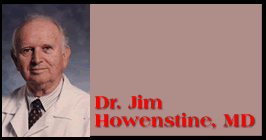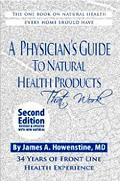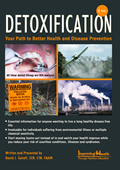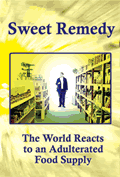HOW
SYSTEMIC ENZYMES WORK TO CURE DISEASES
PART
2 of 2
By Dr. James
Howenstine, MD.
March 17, 2009
NewsWithViews.com
Fibromyalgia
Fibromyalgia (FM) afflicts approximately 6 million persons in the USA, predominately women in the 20-40 age bracket. FM is characterized by severe muscle pain, tenderness in 18 points where muscle and tendons merge, fatigue, headaches(50%), and severely impaired sleep.
This common condition afflicts nine times more women than men. These persons are troubled by severe unrelenting pain in areas where tendons join bone. Estrogen causes the deposition of fibrin, which can lead to impaired circulation with sludgy blood flow in the areas of fibrin accumulation. Hyperestrogenemia is common in our modern world.
The etiology of fibromyalgia is complex and not completely understood at this time. A multitude of infectious organisms have been found using high –resolution microscopy. The list of infectious pathogens identified in patients with fibromyalgia includes mycoplasma, anerobic bacteria, several types of fungi, and borrelia burgdorfi (Bb). The fungi appear to play an important role in causing endocrine dysfunction, presumably by the mechanism of releasing neurotoxic substances, into the bloodstream, which disrupt the normal function of the hypothalamus producing hypothyroidism and hypo-adrenal function.
Several patients with fibromyalgia have recovered when taking the Japanese enzyme nattokinase made from fermented soybeans. This improvement may have occurred because the enzymes are able to reverse the adverse effects of fibrin production and thus improve the circulation of blood into fibrotic areas. Other enzyme products (Wobenzyme, Vitalzyme, Lumrokinase) might also be valuable by the same mechanism.
Systemic Enzymes in Kidney Diseases
Acute and chronic glomerulonephritis are common kidney diseases. The patient with acute nephritis often has high blood pressure, swelling of the extremities, and blood and protein in the urine. This disease is considered frequently to be the result of an allergic reaction to the presence of streptococcal or other bacterial organisms in the body. Circulating immune antigen antibody complexes are common, and if the disease does not soon spontaneously resolve, scarring and fibrin deposits in the kidney’s urine forming units (glomeruli) are found.
Chronic damage to the kidney in time may lead to uremia, dialysis, and kidney transplantation. The presence of fibrin deposits, scarring of the kidney and circulating immune complexes makes a course of systemic enzyme therapy a good choice for these patients. This therapy is safe and has good potential to be beneficial.
Other kidney diseases that could also be helped by systemic enzymes include Goodpasture’s syndrome, Henoch-Schoenlein purpura, Mixed cryoglobulinemia, IGA nephropathy, periarteritis nodosa, Wegener’s granulomatosis, hemolytic uremic syndrome, hypersensitivity vasculitis, interstitial nephritis (drugs may cause this---antibiotics like gentamycin, vancomycin, amphotericin, etc., phenacetin, non-steroidal anti-inflammatory agents like naprosyn and indocin, and many chemotherapy drugs, —or infection such as pyelonephritis).The pathology of swelling, inflammation and scarring(fibrosis) in all these conditions could be helped by systemic enzymes.
Use of Enzymes in Trauma
Serious injuries are usually followed by massive swelling and considerable pain. Immediate therapy with enzymes can dramatically shorten the disability and quickly resolve the pain. The key to this therapy is to take enough enzyme immediately as the battle is being lost when swelling and pain appear. Rehabilitation and recovery will be delayed. It is far more effective to use too much enzymes early than to have to frequently raise the enzyme dose because pain and swelling is spreading.
Lowering the enzyme dose is simple. This may call for using 15 to 20 capsules of systemic enzymes three times daily for injuries such as severe auto accidents with multiple fractures, dislocated hips or shoulders and following knee and hip replacements. Most likely the recovery period from joint replacement surgery could be significantly shortened if orthopedic surgeons used systemic enzymes. Patients taking enzyme therapy should stop this therapy 24-36 hours prior to elective surgery and resume the therapy 24-36 hours after the operation. Taking enzymes during the immediate post-operative period could prevent the normal occlusion by fibrin in small blood vessel lacerations, which might produce oozing of blood with anemia postoperatively. German surgeons have effectively used enzymes in surgical patients for many years. Remember it is more effective to decrease the dosage when things are going well than to increase the dose when pain and swelling have gained the upper hand. Large doses of enzymes do not cause side effects.
My personal experience made me a believer in enzyme therapy. One of my molars needed a root canal, which I knew was dangerous in my diabetic state as it always creates an abscess in the root canal tooth which can never be sterilized. The extraction of the molar tooth was quite difficult as it required continuous effort by 2 dentists for 90 minutes. One of them later admitted it was one of the most difficult extractions he had ever performed. Within an hour I began taking 900 mg of bromelain three times daily (large dose). Neither pain or swelling appeared which surprised the dentist.
Enzymes and Estrogen Excess States (Fibrocystic Breasts, Fibroids of the Uterus, Endometriosis, Polycystic Ovaries, Benign Prostatic Hypertrophy, Cancers of Breast, Prostate, Uterus, Ovary).
Estrogens are able to produce fibrosis, and this capability leads to these painful disorders.
Several factors are producing the estrogen excess status that is widespread in the developed world:
•
Breakdown of petrochemicals, pesticides, herbicides, plastics, sodium
lauryl sulphate from cosmetics, propylene glycol, vehicle exhaust, and
other agents into estrogenic substances in the human body.
•
Extensive use of estrogenic hormones to expedite growth of cattle and
chicken.
•
Use of powerful pharmaceutical estrogens(Premarin) and oral
contraceptive pills that magnify the existing estrogen excess in the
female body.
•
Misuse of estrogens in therapy as a sole agent instead of combining
natural estrogen with safe natural progesterone, which nullifies the
adverse effects of estrogen alone therapy.
•
Diets high in sugar and dairy products, and low in fiber result in
recycling estrogen into the body instead of elimination in the stools
which occurs on high dairy diets. These diets also interfere with
proper production of progesterone by the corpus luteum of the ovary.
Because of this state of estrogen excess, fibrosis, and painful cysts appear in breast tissue(fibrocystic disease of the breast). Many women cease ovulation 10 or more years before menopause due to this estrogen excess state. These women are thus unable to benefit from the estrogen ameliorating effects of progesterone production by the corpus luteum. The heavy intractable bleeding they experience often leads to hysterectomy. Existing fibroids in the uterus tend to appear and steadily enlarge under the stimulation of excessive amounts of estrogen.
Many women suffer from endometriosis, which seems to be produced by retrograde flow of blood into the peritoneal cavity at the time of menstruation. This fluid entering the peritoneal cavity contains blood and shed endometrial cells. A profound inflammatory reaction appears which often results in severe pain. Recurring episodes of this problem leads to “chocolate cysts” and scarring at the site of these peritoneal deposits. An unfortunate result of endometriosis is scarring of the fallopian tubes and sterility. The patient with endometriosis might need 5 or more capsules of enzymes three times daily until their pain disappears. Some women can ascertain when menstruation is imminent. These women could possibly be helped by starting enzymes before they notice the onset of menstrual pain.
Enzyme therapy can stop the development and enlargement of existing uterine fibroids. Patients with fibrocystic breast disease and enlarging fibroids should stay on enough enzyme therapy to prevent symptoms. Whether high doses of enzyme therapy over prolonged periods of time could completely dissolve large fibroids is not known, but it might well do so and appears to be worth a trial.
Another
worthwhile approach to estrogen excess uses enzymes (DeAromatase[1]) which
effectively corrects this problem by blocking the actions of the
enzymes aromatase and 5 alpha reductase so that estradiol, testosterone
and progesterone levels return to normal. Without this enzyme therapy
androstenedione and testosterone are steadily converted into estrogen
(estradiol). This raises already elevated levels of estradiol and
diminishes already low levels of testosterone. To make matters even
worse the enzyme 5 alpha reductase at the same time is converting
testosterone into di-hydrotestosterone the substance believed to be
responsible for some prostate gland enlargement.
When DeAromatase therapy comes on the scene progesterone begins to
inhibit the action on 5 alpha reductase causing rising testosterone
levels and reducing the amount of estrogen formed.
Both testosterone and progesterone promote the p53 gene leading to
normal healthy cell death (apoptosis) while estradiol promotes the Bel
2 oncogene which blocks normal apoptosis (cellular death) and causes
cancer.
Arteriosclerosis and Enzyme Therapy
One of the potentially most useful areas for enzymes is in stopping the progression, and hopefully promoting regression of arteriosclerotic plaques. Excessive clotting caused by infectious inflammatory reactions in the body is now believed to play an important role in the causation of arteriosclerosis. This can be reversed by the fibrin lysis occurring during enzyme therapy. Three cases illustrating clear improvement in arteriosclerotic symptoms after enzyme therapy are presented later in this article.
Keloids
Some patients develop thick unsightly scars(keloida) after surgery or injuries. Taking systemic enzymes following the surgery can prevent this excessive scar formation. Knowledgeable plastic surgeons use enzymes to minimize scar formation after surgery.
Case Reports
Case 1 A patient with a hip defect had considerable pain and difficulty walking. After starting serrapeptase he became completely pain free and walked in a normal fashion for the first time in years.
Case 2 A 34-year old male had a bad family history for vascular disease(three grandparents died of vascular disease at 56. 56, and 63 years of age, and his mother died of a heart attack at age 62). This patient took a prolonged course of intravenous chelation along with measures to correct arterial disease (high dosage vitamin C). He then had an ultrasound study of his carotid arteries , which revealed 12% narrowing of the right carotid artery and 14% narrowing of the left carotid artery. The site where the right carotid artery bifurcates into two arteries had a 24% narrowing. He increased his vitamin C dosage to 10-12 grams daily, started taking 1.5 grams of lysine three times daily, and also took folic acid, B12 sublingually, twice daily, B6, and trimethylglycine. Serrapeptase 10 mg twice daily was begun. A repeat carotid artery study in 18 months disclosed complete resolution of all plaques in the carotid arteries. Vitamin K2 45 mcg. daily which removes calcium from arteries and moves it into bones would probably also have been a worthwhile therapy.
Case 3 In 1945, a six year old child and a friend fell into a pocket of radioactivity (about 650,000 millicuries of Iodine 131 exposure) while playing a game. He immediately noticed burning in his lungs and trouble breathing. His friend died within a few months. And the girl who pulled him out of the hole died of the effects of radioactivity at age 35. He developed severe dyspnea with any exertion along with wheezing and scarring of his lungs and other organs.
At age 63, a knowledgeable physician urged him to take Vitalzym as, “It will dissolve the scar tissue.” His pulmonary function improved by 25% and he can now climb two flights of stairs without difficulty.
Case 4 A man with severe angina and claudication was not improved by laser therapy, robotic therapy, or endarterectomies of his coronary arteries. Therapy with ozone saunas and calcium EDTA chelation relieved his symptoms, but with exertion he still had problems. After a few days of Vitazlym, along with ozone saunas and chelation he was able to resume hunting. fishing, and hiking without any pain in his chest or legs.
Case 5 A man with angina at rest and claudication after walking 15 feet improved with calcium EDTA and ozone saunas. Within 2 days on Vitalzym he was able to walk to the grocery store without stopping or having either chest or leg pain.
Case 6 This woman had temporo-mandibular joint pain for several years with no response to laser surgery surgery, physical therapy, or acupuncture. Sleeping and eating were impaired due to pain. After two months of Vitalzym, she was pain free and much improved.
Case 7 This mother had her 18 month old son do a back flip onto her nose and the back of his head. smashed her nose. She was in severe pain with immediate swelling of her nose, cheeks, and eyes. She placed an ice pack on her face and took 20 Vitalzym. The swelling began to disappear and the pain was nearly gone by the following morning. After 10 more Vitalzym capsules the next morning, the pain and swelling disappeared.
Hospital Formularies and Systemic Enzymes
Because systemic enzyme therapy was developed in Europe and the Far East, most US physicians are certainly unfamiliar with it. This means that patients landing in hospitals with some of these previously discussed problems may find themselves in an institution that does not stock systemic enzymes. Hospital formularies lean heavily toward pharmaceutical drugs, so the systemic enzymes may not be in the formulary unless unless the hospital is staffed by some knowledgeable plastic surgeons. Furthermore, hospital formularies do not like to stock a product that will be used by only one patient as unused portions of the product may expire. Even without the availability of enzymes in the formulary, some hospitals will permit patients to take outside therapy if the attending physician gives his or her approval.
More Research Needed
In reviewing the available literature about enzyme therapy, it is apparent that not all patients improve. Most studies show 75-80% of patients clearly improve. This raises a very important question. Would higher doses over a longer time frame have benefited those patients who failed to respond to the initial enzyme dosage?
The safety of systemic enzymes in high dosages means that we cannot be certain systemic enzymes would not help a patient until high doses have been tried over longer periods of time. It appears to me that this is particularly relevant in diseases like sarcoidosis, pulmonary fibrosis, scleroderma and uterine fibroids where there is such extensive scarring it would not be reasonable to expect prompt resolution. There is a possibility that severe scarring may not be reversible, but this needs to be proven as reversal of scarring in these serious health problems could be of immense value to the afflicted patients.
Practical Aspects of Enzyme Therapy
Tylenol(acetaminophen) is a very dangerous drug that, in my opinion, should never have been released. This drug is nearly universally found in US homes. Acetaminophen accelerates aging and can cause death from acute necrosis of the liver in young healthy persons who use this drug because of an acute viral infection. None of us needs speeding up of the aging process. Enzymes are far safer than this therapy for pain.
|
Subscribe to the NewsWithViews Daily News Alerts! |
Having Lumbrokinase, Nattokinase, Wobenzyme, Bromelain or Vitazym+ in your home provides a therapy well qualified to alleviate a wide variety of painful disorders without any danger .to the user. The usage of enzyme therapy should increase as more health care practitioners learn about this exciting therapy. Vitalzym + and DeAromatase are available from www.mynaturalhealthteam.com Phone 1-800-416-2806. For part one click below.
Click here for part -----> 1,
Footnotes:
1- Howenstine, J. A Physicians Guide To Natural Health Products That Work, or call 1-800-416-2806
© 2009 Dr. James Howenstine - All Rights Reserved






















